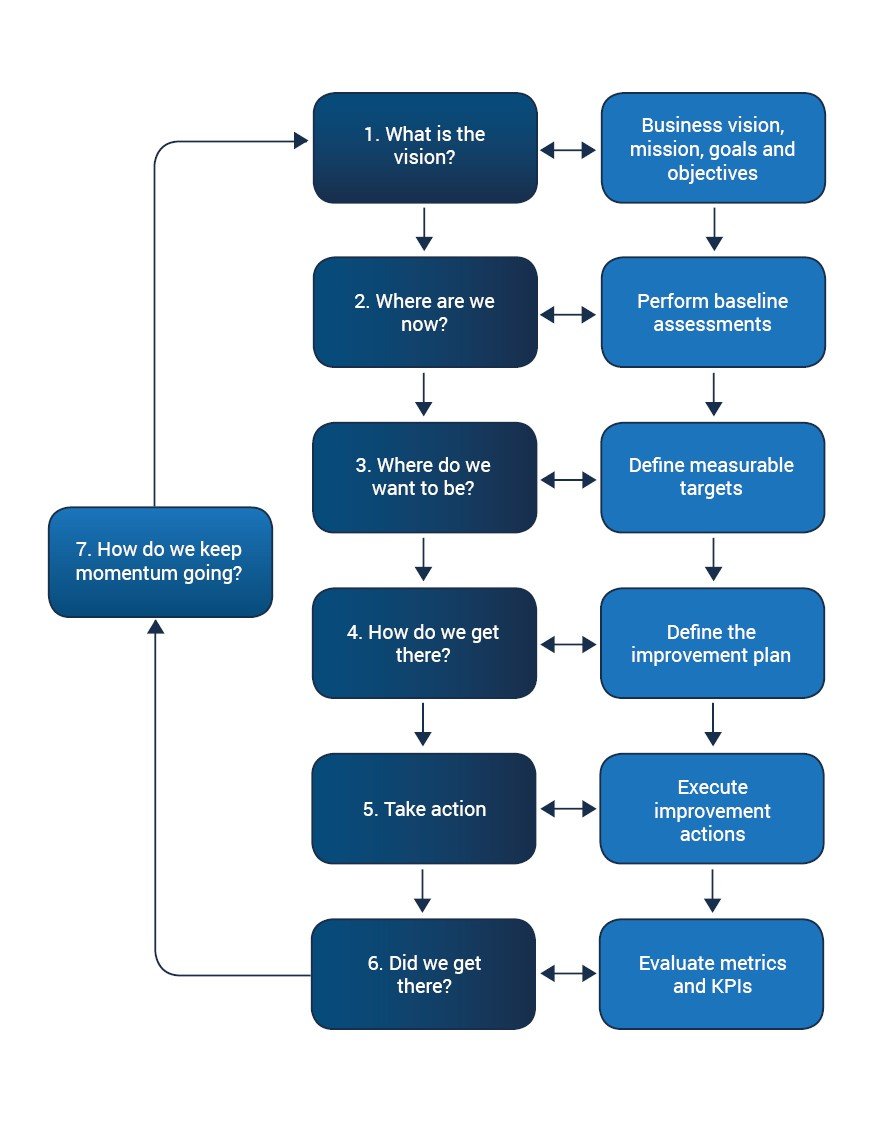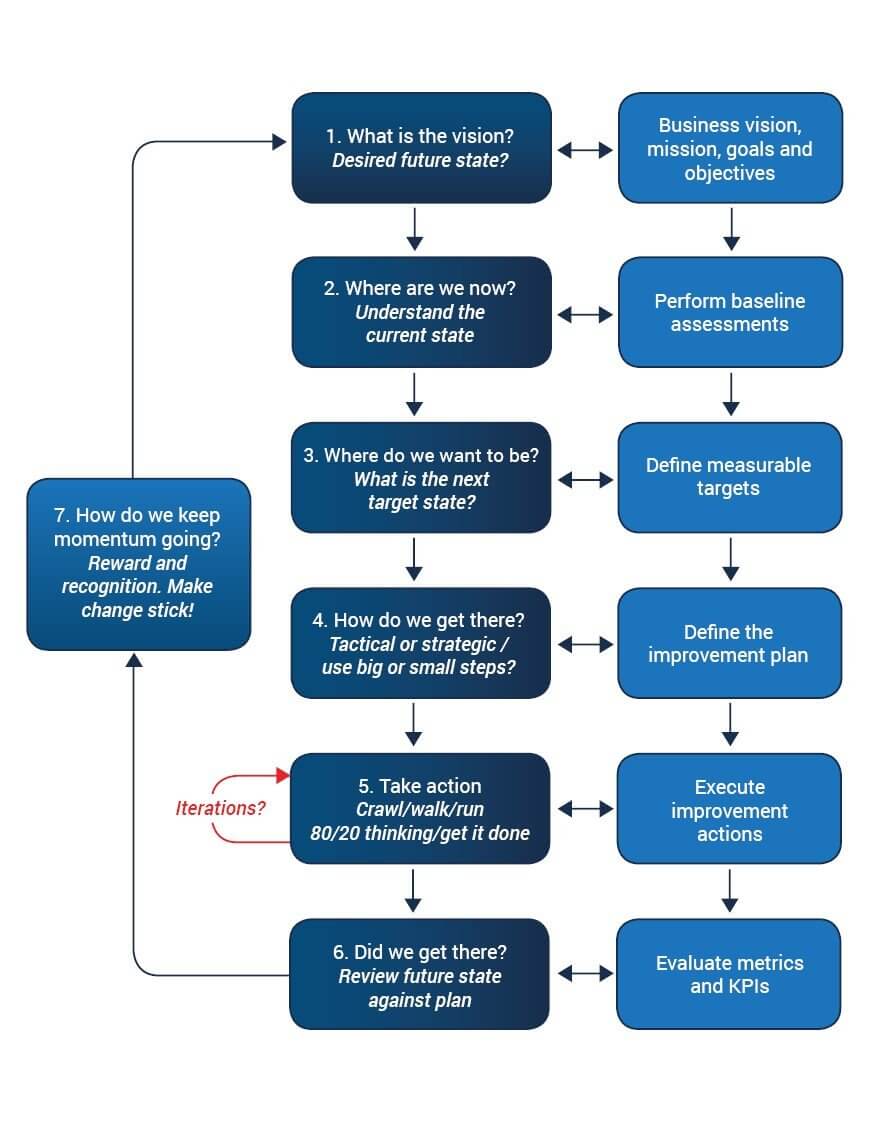5 September 2019 | Updated on 18 September 2019
Things can only get better…
Forget new year for a fresh start – in today’s fast-paced, digital world, businesses can no longer afford to wait for annual milestones to start making changes in their organisation; adopting an impro...
Forget new year for a fresh start – in today’s fast-paced, digital world, businesses can no longer afford to wait for annual milestones to start making changes in their organisation; adopting an improvement mindset has to become ‘part of the furniture’, as it were.
Part of ITIL®’s entire culture is the concept of continual improvement – the idea that you are constantly in an almost cyclical rhythm of improving processes and outcomes in small, continuous, iterative stages. And part of this, naturally, includes a continual improvement model.
The model itself (taken from pg. 66 of the ITIL®Foundation handbook, ITIL 4 edition) offers organisations a structured approach to implementing improvements. With a keen focus on providing customer value, it not only supports an iterative method that divides the workload into manageable chunks, but it puts a strong emphasis on linking everything back to the organisation’s visions and goals, across all areas and at all levels of the business.

So, how does it work? Let’s break it down…
Step 1: what is the vision?
At this initial stage, a high-level vision for the planned improvement is created, linking the organisation’s overall business goals and initiatives to an individual business unit or department. Doing this gathers an understanding of what ‘good’ looks like and the desired future state, and ensures that the whole process is tied to the core business vision from the start.
Step 2: where are we now?
Any journey starts with an understanding of where you are. This step’s key focus is performing a current state assessment, looking at all aspects of the business, including current capabilities, the existing services, the processes and procedures, etc. Doing this gives you a baseline measurement from which you can gauge, later down the line, how effective the improvements have been.
Step 3: where do we want to be?
Based on what you’ve found in the first two stages, you can now assess where you want to be, and define some prioritised actions to get you there. An important aspect to note here is that improvement is the aim, not perfection. You may never achieve the initial vision in full, and there may be a number of interim stages along the way, but putting tangible goals in place will ensure that the target state remains clear throughout.
Step 4: how do we get there?
Now, armed with a beginning and end to your journey, you can plan how to get there. Without a plan of action, the execution of the improvement can fail and confidence in the change can dwindle. How you approach implementing the change may not be clear, so experimenting with different options can help – is it a purely strategic change or part strategic and part tactical? How ambitious do we wish to be? And so on…
Step 5: take action
Regardless of your approach – waterfall, agile or a combination of both, perhaps – it is now time to act on the improvement. It is important to remain flexible and open to change throughout this step, as sometimes a revised approach is required, but following this you should find yourself in a new current state, ensuring what is intended to get done is indeed done.
Step 6: did we get there?
It’s sometimes tempting, once you’ve reached an end point, to assume that the expected benefits have been achieved and move on. However, at each and every step of the continual improvement model, the progress and the value need to be checked and confirmed to ensure the desired result has been achieved – compare planned results with actual results, learn any appropriate lessons, and prepare to celebrate any achievements.
Step 7: how do we keep the momentum going?
If the improvement initiative you delivered was successful then these successes need to be embedded, recognised and rewarded – whilst adopting any new methods used – throughout the business, where appropriate. This ensures that continual improvement is rooted into the organisation’s culture, and the risk of reverting back to the old current state is greatly reduced.
An example of what an enhanced contextualised continual improvement model might look like is shown below:

To view this model in context, let’s take a look at property management. Today, around 4.3 million homes in the UK are estimated to be leasehold properties, but the property management sector is highly competitive and generally poorly digitised.
So, imagine a disruptive property management company, working on behalf of freehold landlords, has been appointed. They want to improve their overall performance and, in particular, their communication with both freehold and leasehold customers. A simple digital transformation continuous improvement initiative for them could look something like this:
- What’s the vision?
- Communicate more effectively using digital channels with leaseholders and freeholders
- Reduce the level of service charge arrears from leaseholders
- Reduce the number of complaints from leaseholders and freeholders
- Keep everyone satisfied with our performance
- Where are we now?
- Communication twice a year
- High levels of service charge and ground rent arrears
- High numbers of complaints from leaseholders
- High levels of contract termination of property management companies
- Where do we want to be?
- Provide a property-specific portal for all managed properties
- Reduce service charge and ground rent arrears to lower than 5% across any development
- Reduce complaints from leaseholders and freeholders to fewer than are currently experienced
- Longer term business from freehold customers
- How do we get there?
- Introduce a property management portal with near real time data
- Communicate digitally to all leaseholders and freeholders about property matters
- Seek timely feedback from leaseholders and freeholders about progress made on works and issues
- Take action
- Create a simple easily-upgradeable, secure online property management portal
- Communicate the existence of the portal and any changes to portal content
- Manage the property accounts with timely reminders
- Include FAQ and service request capability on the portal
- Did we get there?
- How many user accounts have been created and how often are they used?
- What is the property account cash flow? Has it improved and met target metrics?
- Are issues and complaints being handled more effectively?
- How do we keep the momentum going?
- Where appropriate, celebrate successes
- Show customers how they are receiving great service
- Get feedback from leaseholders and freeholders to improve their services further
- Reward and recognise those involved for their contributions
If you’d like to find out more about how the Continuous Improvement Model fits into the ITIL 4 approach, or the training options available for ITIL 4, visit our ITIL course page, or get in contact with a member of our team.